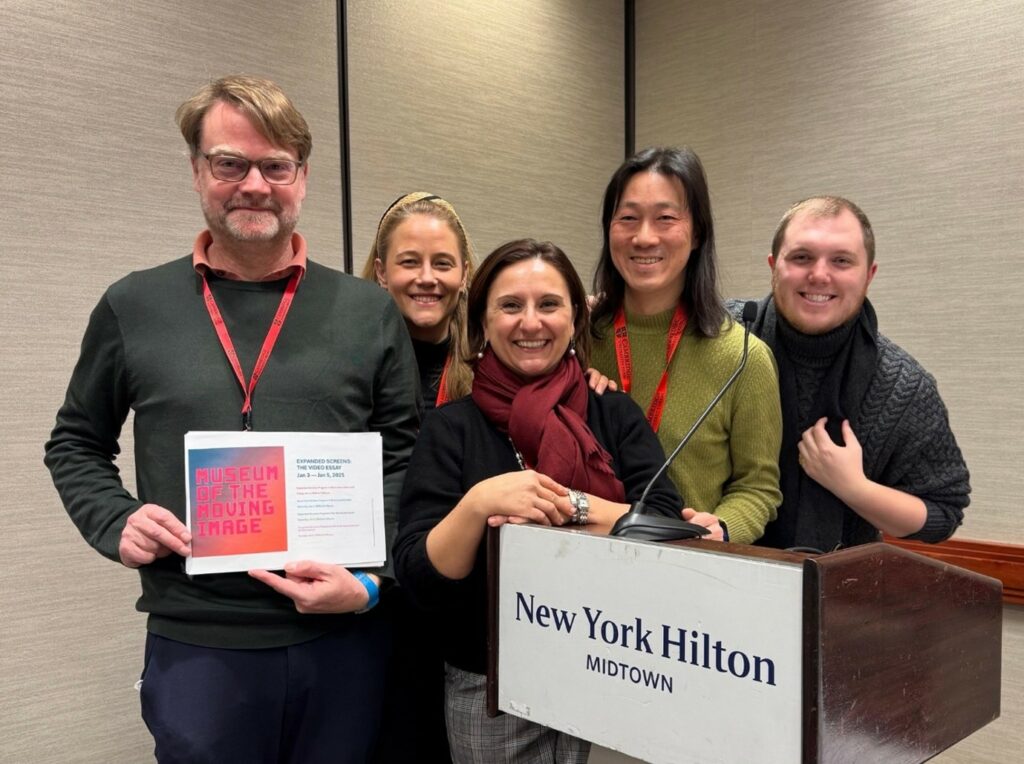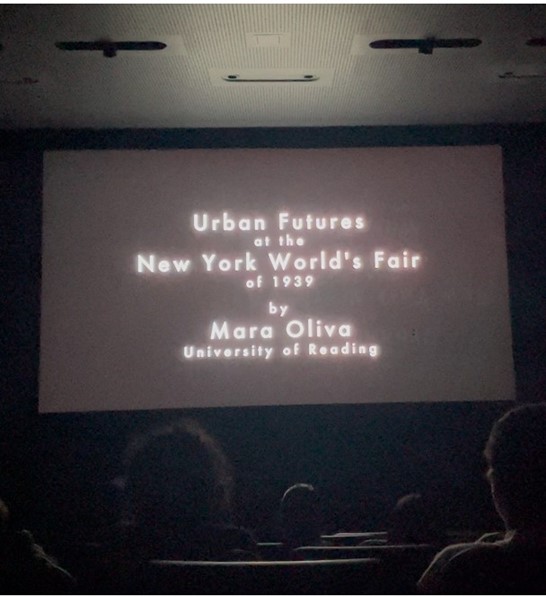Standing before an audience of historians at the American Historical Association (AHA) annual conference in New York City in January 2025, I experienced a moment of both exhilaration and trepidation. I was part of a distinguished panel that included Professor John Gibbs (University of Reading), Dr. Evelyn Kreutzer (Universita’ della Svizzera Italiana), and Professor Kevin B. Lee – one of the pioneers of the video essay as a scholarly form – chaired by Will DiGravio, host of the Video Essay Podcast. This was not just any presentation; it was an opportunity to contribute to a dynamic methodological conversation.

As part of my talk, I presented key insights from my research on the 1939 New York World’s Fair and showcased selected segments of my video essay: “The City of Tomorrow” (currently under review with the American Historical Review). The session was an exploration of how videographic criticism, originally rooted in film studies, is reshaping historical scholarship. As the lights dimmed and my work appeared on screen, I reflected on the journey that had brought me here – a journey shaped by the mentorship of Professor John Gibbs and the transformative potential of videographic criticism.
Beyond the AHA conference, my video essay was also featured as part of a four-screening program (curated by Di Gravio, Gibbs, Kreutzer, Lee and me) at the Museum of Moving Image, an institution renowned for its dedication to cinematic and media histories. This additional platform highlighted the growing recognition of the video essay as both a scholarly and artistic medium, reinforcing its legitimacy within both the historical and film studies communities.

A vision of the future
My video essay delves into the grandeur and symbolism of the1939 New York World’s Fair, a spectacle that embodied modernity, progress and American aspirations on the eve of World War II. With the theme “The World of Tomorrow,” the fair projected an optimistic vision of the future, boasting pavilions that showcased cutting-edge technology, streamlined architecture and utopian ideals. From General Motors’ Futurama exhibit to the dazzling Trylon and Perisphere, the fair reflected both the promise and contradictions of its era.

Rather than relying solely on text-based analysis, my video essay weaves together archival footage, photographs, voice-over narration and music to construct a layered historical interpretation. By juxtaposing images of corporate-sponsored progress with contemporary critiques, I explore the fair’s legacy, questioning whose vision of the future was being promoted and at whose expense. The medium of the video essay allows me to communicate these ideas in a dynamic and immersive way that a traditional conference paper could not.
Videographic criticism: a new methodology for historians
The video essay represents a significant departure from traditional historical methodologies. Originating in film studies, videographic criticism emerged as a tool for analysing cinema through its own visual and auditory language. Rather than writing about film, scholars could manipulate filmic elements – editing, montage, sound design – to construct arguments in a medium-specific way.
My own introduction to this methodology was made possible by Professor John Gibbs at the University of Reading. Having been one of the participants in the first of the pioneering workshops held at Middlebury College, which have been instrumental in establishing the video essay as a research methodology in Film and Television studies, he recognised its potential beyond film analysis and began providing training for colleagues working in a variety of disciplines at Reading. His summer school, which I was fortunate to attend, provided a crucial foundation in editing techniques, narrative structure and the theoretical implications of videographic criticism. With the guidance provided by him and other colleagues in Film, Theatre & Television, I was able to experiment with historical sources in new ways, moving beyond the written word to create a visual argument that engaged both intellect and emotion.
Crucially, the video essay is not just a communication medium but also a research methodology in its own right. I was already familiar with the archival collections housed at the New York Public Library and had previously published traditional outputs using these collections. However, by applying the exercises taught at the summer school, and benefiting from the interdisciplinary conversation as the participants fed back on each other’s work, I discovered new insights within the sources, understood fresh angles and reached new arguments. The videographic approach allowed me to notice patterns and relationships that had previously gone unexamined, demonstrating how the act of assembling and editing historical materials can itself be an interpretive process.
Video essays and the digital humanities
The video essay is also an integral part of the digital humanities, a field that embraces digital tools and methodologies to expand the scope of traditional scholarship. By leveraging the affordances of digital media – such as nonlinear storytelling, interactive elements, and audiovisual analysis – the video essay enables historians to approach sources in new ways. The digital humanities encourage scholars to think beyond the printed page, and videographic criticism fits squarely within this paradigm, offering a form of multimodal scholarship that challenges conventional notions of historical argumentation and dissemination.
As digital humanities initiatives continue to grow, incorporating videographic methodologies into historical research presents exciting possibilities. Not only do video essays serve as powerful tools for public engagement, but they also open new avenues for interdisciplinary collaboration. By embracing digital technologies, historians can present their work to wider audiences, making scholarship more accessible and engaging while maintaining rigorous academic standards.
Challenges and rewards
The transition from traditional historical research to videographic scholarship was both exciting and daunting. Historians are trained to communicate through written argumentation, carefully crafting narratives supported by footnotes and citations. The video essay required me to rethink my approach, considering how images, sound and editing rhythms could construct meaning in ways that text alone could not.
Archival research took on a new dimension. Instead of solely reading primary sources, I sought out historical footage, audio recordings and photographs that could be woven together to tell a compelling story. Editing became an act of historical interpretation – deciding how to sequence images, when to juxtapose conflicting perspectives and how to use music and narration to evoke specific responses. The final product was not just an argument about history but an immersive historical experience.
Of course, this new methodology came with challenges. Developing technical proficiency in video editing software was a steep learning curve, and the process of assembling archival footage and other elements required persistence and creativity. Additionally, presenting a video essay at a history conference – where traditional papers remain the norm – meant navigating questions about scholarly legitimacy and methodological rigor. However, the overwhelmingly positive response from the audience at AHA affirmed the value of this approach. Historians, after all, are storytellers, and the video essay offers a compelling new way to tell those stories.

Presenting my first video essay at AHA 2025 and seeing it screened at the Museum of the Moving Image was a defining moment in my academic journey. It reinforced my belief in the importance of evolving methodologies in historical scholarship and the potential of the video essay to bridge the gap between academia and public engagement. The 1939 New York World’s Fair, with its promise of a future shaped by innovation, proved to be the perfect subject for an experiment in new ways of historical storytelling. And just as that fair once inspired visions of tomorrow, I hope that this experience marks the beginning of a future where videographic scholarship plays an integral role in historical research and communication.
Mara Oliva is Associate Professor in the Department of History and Digital Humanities Academic Champion at the University of Reading.

